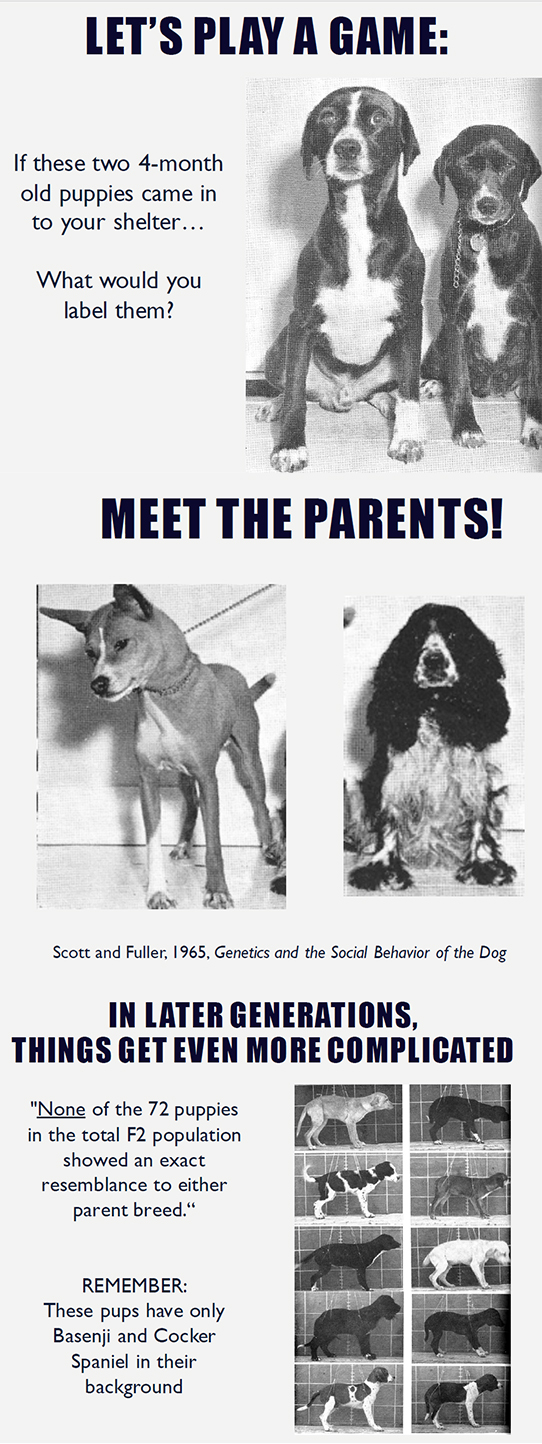Where did breed go?
JULY 14 , 2016 -- If you’ve visited our website today, you may have noticed that the dog breed identification field is missing. It’s just gone. Poof! No, it’s not an error. Or a website glitch. It’s part of an exciting pilot program we’ve launched that intentionally removes breed labels for shelter dogs.
Why on earth would WHS do that? Well, we know breeds exist, of course. But the reality is that the majority of dogs entering our shelter are mixed breed dogs. And no one can accurately assign a breed label based solely on appearance.
You often find shelter staff cocking their heads to the side, squinting their eyes and uttering something like, “…ummm, maybe a Shepherd? Tail looks kind of Lab but feel her coat. Coloring is almost Husky/Shepherd mix. Weird. And maybe her ears just aren’t erect yet because she’s so young…”
Here’s some fun trivia for you: the dog genome consists of approximately 20,000 genes, but only 50 of those genes (in various combinations) define a dog’s appearance. So when we’re assigning breed labels based on what a dog looks like, we’re basing that guess on less than 1% of their genetic makeup.
This is a fact worth repeating – less than 1% of a dog’s genes determine physical appearance. Looks don’t equal behavior. Appearance is only one tiny piece of the genetic puzzle.
But our software and other processes have long demanded that we enter breed. So given what we see, we assign a breed and usually two. And sometimes we’re right. But most times we’re probably wrong. But most importantly, when we assign a breed, we set expectations about size, behavior, personality, and the appearance of the dog.
Because breed is often wrong, expectations are often wrong. Sometimes that “Jack Russell” gets adopted and wants nothing more than to nap all day with his cat friends. The “Chow Chow” prefers a 5K run after his morning swim, much to the dismay of his adopter. When a label is inaccurately applied, breed expectations can feel misleading and frustrating for our clients.
The most honest answer we can provide when we are asked, “What breed is she?” is “I don’t know.” Breed labels are often well-intended guesses, but can lead to false expectations, and we prefer to focus on the individual attributes and personality of the dog.
So, what if the dog is purebred? Will a breed label still be omitted? If the dog arrives at WHS with papers indicating that he is from a purebred lineage, we will certainly share that information. If the dog just looks purebred, we won’t assign a label because we don’t know for certain. But we do know that looks can be deceiving. (Check out the images below to be convinced, if you aren’t already.)
Remember, this is a pilot program. A few shelters across the country have tried it, with great success. We are also learning along with you over the next few weeks, and appreciate the community support that allows us to do this. Being able to try new approaches and experiment with innovative ideas makes us better, improves the lives of animals and enriches the community. Thanks for allowing us to do that, and we welcome your feedback and questions!
To learn even more, check out these fantastic resources:
- https://www.animalsheltering.org/magazine/articles/whats-label
- https://animalfarmfoundation.wordpress.com/2013/10/09/a-closer-look-at-all-dogs-are-individuals-infographic/
- https://animalfarmfoundation.wordpress.com/2015/06/15/removing-breed-labels-easier-than-you-think/
And, just for fun:

- Thursday, July 14, 2016
